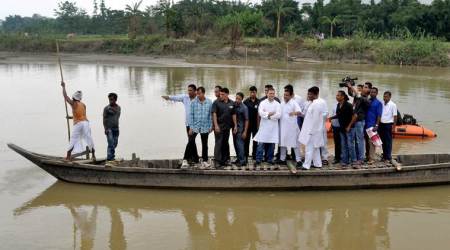 The Tricolour hoisted at the flooded Jakhalabandha police station in Assam on Tuesday. Express photo by Dasarath Deka
The Tricolour hoisted at the flooded Jakhalabandha police station in Assam on Tuesday. Express photo by Dasarath Deka
LIVING JUST four kilometres from the Brahmaputra, this is not the first time that Abani Sarma, 78, has been forced to flee home and take refuge in a relief camp. But this time, he says, he did not get enough time to grab his possessions — his diaries in particular, all carefully preserved in three steel trunks since 1962.
“I began writing my first diary in November 1962, when the Chinese marched into India through the Kameng frontier. Since then, I have recorded all important events, including their local implications. I managed to save those diaries during the last big flood of 1973, because we got enough time to escape,” says Sarma, a resident of Bor-Bhakati village.
Sarma is among the over 1,200 people from five neighbouring villages — Bor-Bhakati, Dulal-Madhav, Miribheti, Sonaribagan and Nagshankar — who have taken shelter at the Sonari-Kamakhya MV School here, after their villages were submerged soon after midnight on Saturday. The school was converted into a relief camp by residents of Sonarigaon, about 180 kilometres from Guwahati.
On Tuesday morning, as school headmistress Labanya Saikia hoists the national flag, Sarma and the others gather around to sing the national anthem.
“On August 15, 1947, I accompanied my father to witness the first flag hoisting at Silghat,” recalls Mohan Bordoloi, the gaon burra (village headman) of Sonarigaon.
Old timers recall how then Prime Minister Jawaharlal Nehru walked through Sonarigaon in 1959. The neighbouring village, Kamakhyagaon, has a library named after his sister Vijayalakshmi Pandit.
“I clearly remember a local girl, Bhogila Hazarika, garlanding Nehru near a gate that the villagers had erected to welcome him,” says Bordoloi.
After the brief ceremony, the conversation returns to the Brahmaputra.
“When a neighbour, Jitumoni Saikia, called me up at around 1:30 am on Saturday and told me to run for my life because the Brahmaputra had breached the embankment at Hatimura, I did not believe him. But, even as I heard other villagers shouting, the flood water had already entered my house. We just flung open our doors and ran towards Sonarigaon, which is higher than the surrounding area. We ran, carrying just one or two items that we managed to pick up,” says Chandra Mahanta, also of Bor-Bhakati village.
Like Mahanta and Sarma, most of the other villagers at the relief camp were unable to grab anything much from their homes as they fled for their lives.
“I heard that my house, which the government gave me in 1986 under the Indira Awaas Yojana (IAY), has been destroyed. I and my wife somehow managed to reach this school, wading through neck-deep water,” says Lakhidhar Gohain, 55, a vegetable vendor from Dulal-Madhav.
“I had a mekhela-chadar-riha set made of muga silk that my mother-in-law had inherited from her mother-in-law. The almirah in which I had preserved the family heirloom for about 40 years is now under four feet of water, as our house is still submerged,” says Gita Mahanta, 77, of Bor-Bhakati village.
While there have been reports of some flood-affected districts not getting timely relief material, the 27 camps in Kaliabor are better off, partly because the local MLA, Keshab Mahanta, is also the state water resources minister.
The camp in Sonarigaon is managed by members of the local youth club. “Our gaon burra, Mohan Bordoloi, is working almost round the clock, maintaining the records of people as well as relief material coming from the government and voluntary groups,” says Kaustabh Hazarika, secretary of the club.
“While the residents of Sonarigaon contributed rice, dal and vegetables for the first two meals on Sunday, we received relief material from the government by Sunday evening,” says Prasanta Pathak, a club member.
The government has provided 12.5 quintals of rice and 80 kgs of dal, while a Guwahati-based NGO has sent 75 kgs of rice, 40 kgs of dal, 1,500 bottles of water and 600 eggs. “Bhaiti Bora, a local grocer whose shop was submerged, managed to save 40 kgs of rice, which he donated to the camp,” says Pathak.
“One NGO sent 100 packets of sanitary napkins, an item that is not included in the government relief manual,” says Ghanakanti Borah Saikia of Miribheti, a weaver who lost two looms in the flood.

